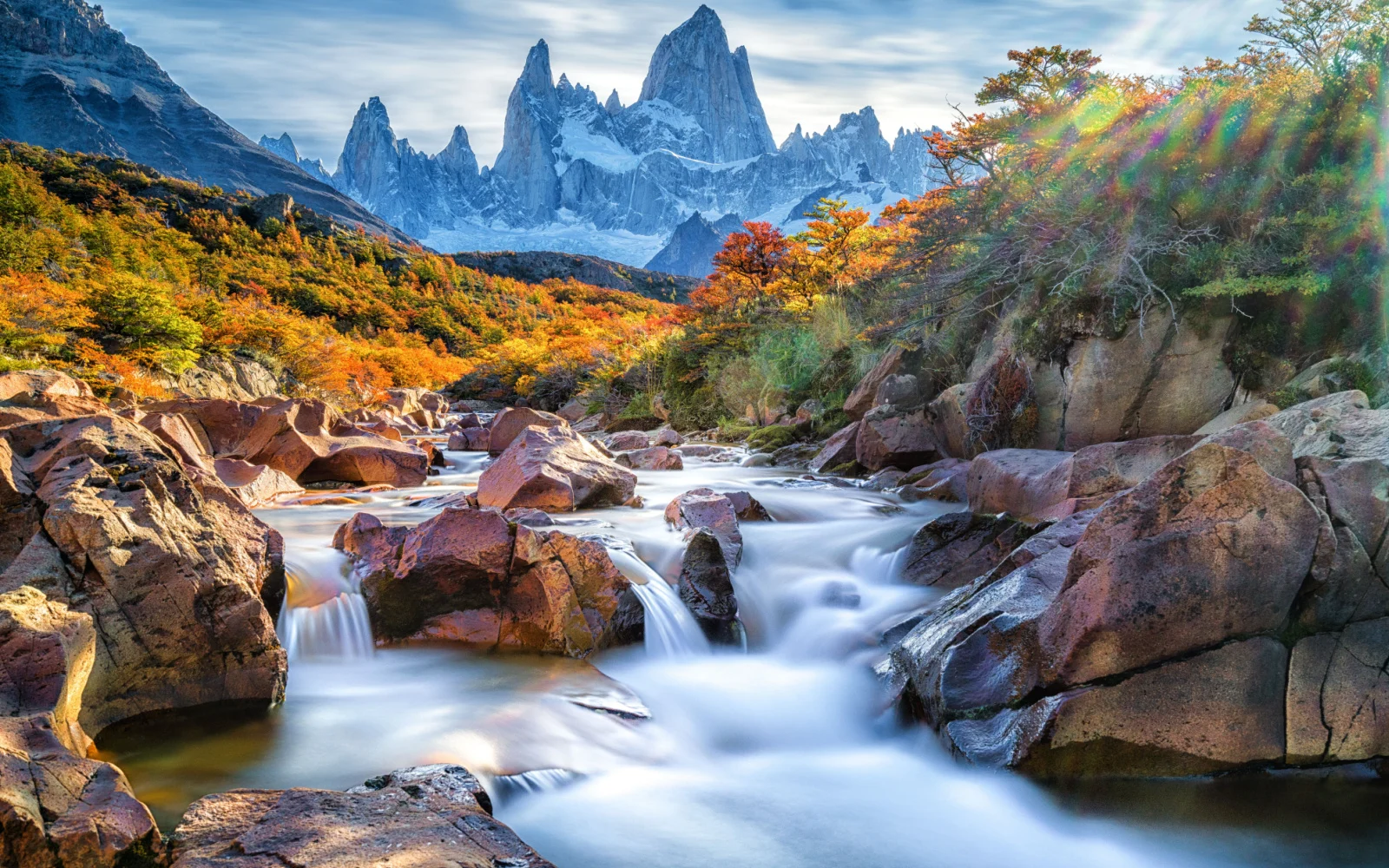What's an average trip to Patagonia cost?
A one-week trip to Patagonia for two people generally costs around $4,500, with average accommodation at $100 per night, flight expenses of about $900 per person, and daily expenses on food, drink, and activities at $100 per person, with overall transportation adding up to $500.
If the mere mention of “Patagonia” conjures romantic images of windswept plains and crystalline glaciers for you, then you’re not alone. Many people long to visit this remote and unspoiled region of Planet Earth, dominating the bottom of the South American continent.
What many people don’t know, however, is that this area – millions of acres in total – extends across the borders of Chile and Argentina, meaning a Patagonia trip will get you to two countries and a dozen national parks (including the eponymous Patagonia National Park), if you so choose.
Therefore, one question many people have is “Where exactly is Patagonia?” Fair, since it is a huge region that dominates the bottom of South America, with vast stretches of wilderness between its boundaries.
As Encyclopedia Brittanica explains, “Patagonia, semiarid scrub plateau that covers nearly all of the southern portion of mainland Argentina.
With an area of about 260,000 square miles (673,000 square kilometres), it constitutes a vast area of steppe and desert that extends south from latitude 37° to 51° S.” As said, it continues into Chile, but that only constitutes 10% of the total landmass it covers.
In any case, it’s an outdoor person’s dream come true, but only if you do it right. Because the area is so large, it’s easy to get lost in the planning or to spend too much trying to get where you’re going.
Read on to learn more about doing Patagonia the budget-conscious way, so that you can see the best of this wondrous region without breaking the bank.
Average Trip to Patagonia Cost in 2025
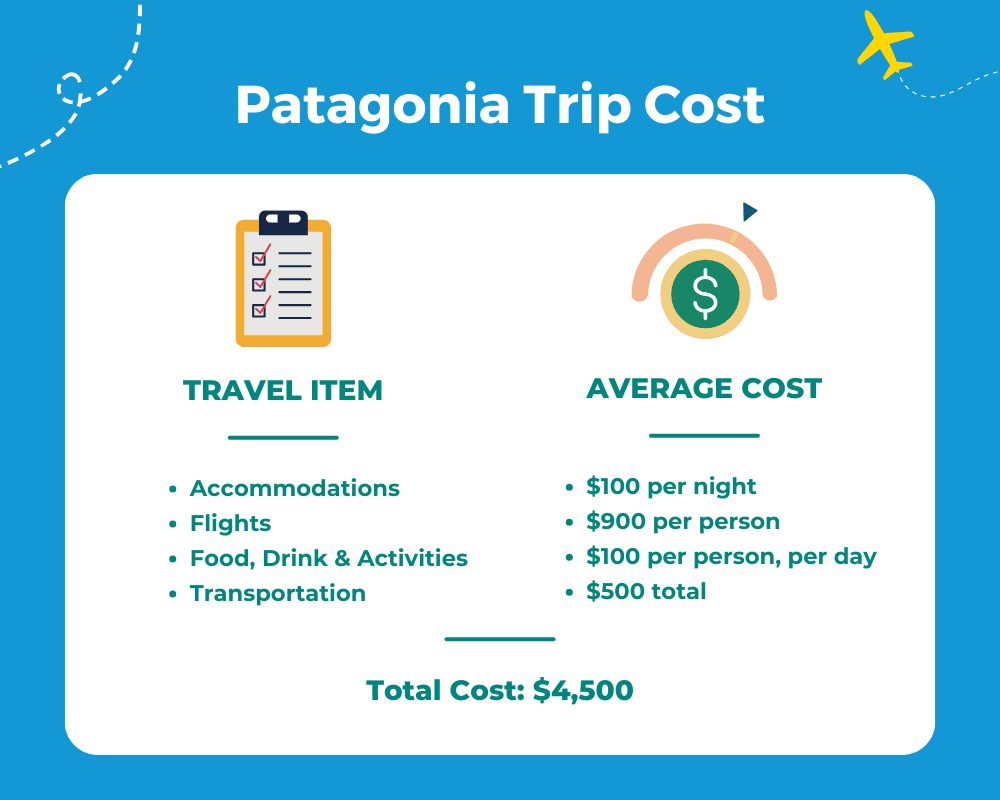
An average one-week trip to Patagonia for two people will cost around $4,500:
- Average Accommodation Cost: $100 per night
- Average Flight Cost: $900 per person
- Food, Drink & Activities: $100 per person, per day
- Transportation: $500 total
- Total Cost: $4,500
Neither Chile nor Argentina is particularly expensive. Both Chile and Argentina have GDPs that are only about a third the size of the United States, so the dollar goes pretty far in this neck of the woods.
Meals are very affordable, but transportation, hotels, and activities often cost more because so many people want to see them.
You can easily overspend your budget if you don’t make a plan, because this area caters heavily to people who have significant funds as well as to budget travelers. Getting the correct figures for your trip to Patagonia requires some patience, but this guide will help you sort it out.
Ready to Book?
Unlock Exclusive Discounts on Expedia.com!
Got Travel Insurance?
Protect yourself for unexpected interruptions.
Compare Plans We may be compensated when you book after clicking on one of our links.Patagonia Trip Cost: Average by Item
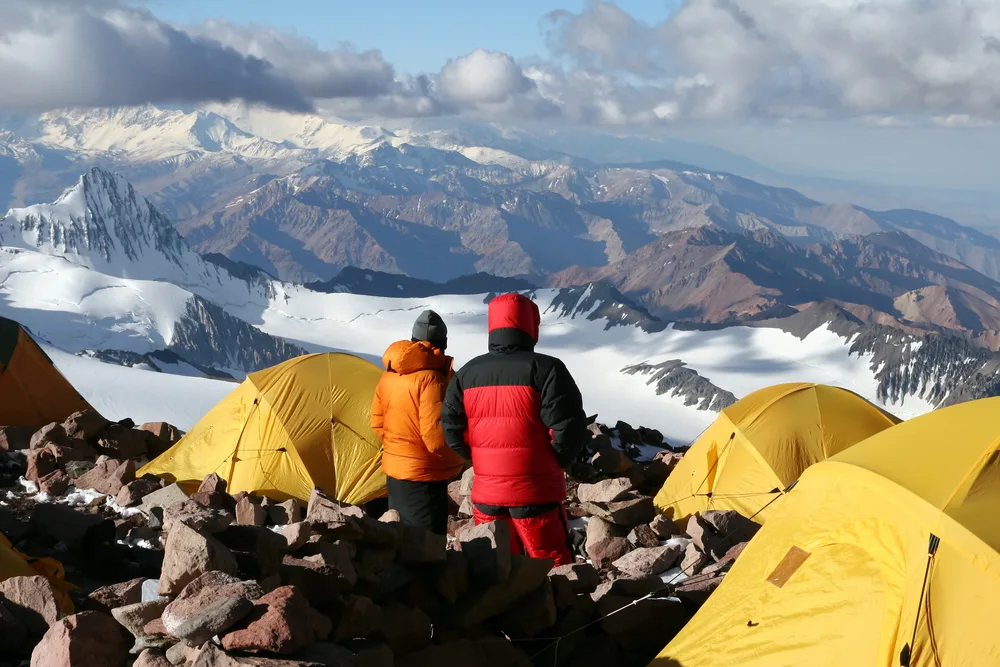
Jason Maehl/Shutterstock
The average cost of a trip anywhere is difficult to come by, because people travel in such different ways. For instance, if you like fancy lodging, you’ll pay more in that category.
If you don’t mind connecting flights that make your travel day 10 hours longer, you’ll pay far less for tickets. And so forth. The best bet is to take a look at the budget categories below and decide which ones you want to spend a lot on, if any, and which are less important.
Note that in this travel guide, I’ve spent a lot of time on outdoor adventures, since that’s usually why people come to Patagonia. Read through those items carefully, then Google more exact figures for the activities that sound fun to you.
Accommodation Costs
Camping in Patagonia is one of the cheapest options for lodging. If you’re going to be out in the wild anyway, you might opt for this. Note that doesn’t mean you need to bring all your gear with you.
Some outfitting companies in Chile and Argentina will rent you tents, sleeping bags, and mats for about $80 per night. In a place like Torres del Paine, where hotels can range up to $300 or more a night, that’s a steal.
If you really want to camp near the big national parks, plan on paying about $150 a night for the more affordable hotels. You can likely get these prices down a bit if you travel in spring and fall (Northern Hemisphere fall and spring).
In the small towns in the Argentinian Lake District, you’ve got less to worry about.
There you can easily find rooms for about $100 per night, and nice ones at that. In Santiago, the capital of Chile, rooms are about the same. Ditto Buenos Aires, the capital of Argentina. Overall, plan on $100 per night.
Flight Costs
A round-trip flight from New York City to Buenos Aires, Argentina, is about $700. From LA, it’s closer to $900.
These prices change to about $750 and $650, respectively, if you’re flying into Santiago instead. Add another $100 on average to get to the major hubs from your hometown. All told, budget about $900 per round-trip ticket to get to Patagonia.
Food, Drink & Activity Costs
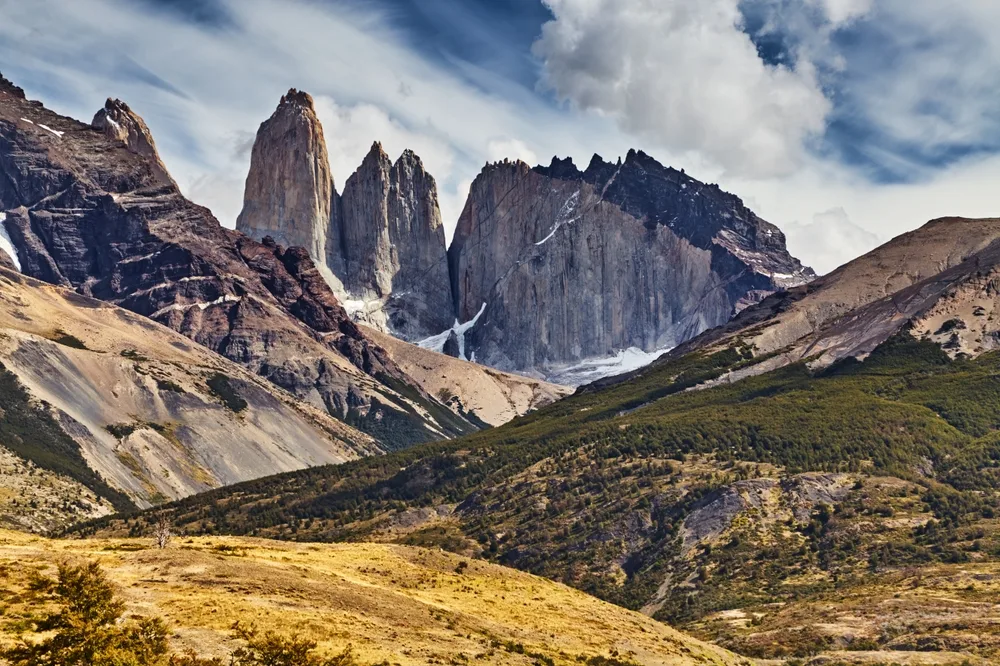
Dmitry Pichugin/Shutterstock
What’s there to see when visiting Patagonia? A better question is, what won’t you see? National Parks are a huge part of the Patagonian experience.
Many people come here to get way out into nature, where there’s neither sight nor sound of human habitation. Spectacular Torres del Paine National Park in Chile is one of the wildest and most beautiful in the world, with glacial peaks reflected into crystal-clear lakes.
This gem sits in Chile, with more information on that and other parks here. Currently, the entrance fee for 3 days is about $35 per person.
In Chile, you’ll also love the Lake District or a cruise through the jaw-dropping fjords on the coastline and around Cape Horn. A day trip will cost you about $240 per person.
In Argentina, check out Los Glaciares National Park, Tierra del Fuego, the steppes and rainforests of Aysen, and the Argentinian Lake District. An all-day cruise on Lake Argentino, where you can view multiple glaciers, will cost about $300 per person.
The great thing about activities in Argentina is that their cost is really up to you. If you want, you can spend hundreds of dollars on a guided trip where transportation is often provided, you get food and drink, and a tour guide to explain exactly what you’re seeing.
If that’s not you, feel free to rent a car in Chile or Argentina – about $35 a day – and drive into the parks yourself. That cost won’t include food, gas, a guide, or the entrance fee, but it will still be cheaper than a tour by far.
The national parks and natural vistas aren’t the only things to see in Patagonia, though. For instance, in the Argentine Lake District in Patagonia, you’ll find the towns of Bariloche, Villa La Angostura, and San Martin de los Andes.
If you love a small-town vibe, these feature sweet churches, beautiful gardens, sunny docks, and gondolas. Point being, you don’t have to head into the bush to enjoy sweeping vistas and gorgeous surroundings.
There are tons of things to do in town, without paying a cent. Food and drink, while they do cost money, are among the more affordable activities. In Argentina, for example, it costs about $7 to eat out at an expensive restaurant, and $25 for two people to get a nice meal.
A beer is only $2 to $3, so you can comfortably eat on $25 a day if you’re careful. Together with various activities, plan on spending about $100 a day if you want to factor in a few expensive activities and park fees.
Transportation Costs
Next up: what are the cheapest ways to cross the vast stretches of land that constitute Patagonia? According to Rome2Rio, there are seven basic ways to get between the two, from bus to plane to automobile – each with its own price.
The last, driving by car, is not cheap. You’ll spend between $170 to $250 on average, depending on your departure and arrival spots. The bust will only cost you about $70 on average, while flights can range anywhere from $100 to $500 – that again depends on departure and arrival points.
Another consideration is how much time it takes to get from one point to another, whether you’re staying inside Argentina or traveling to Chile as well.
Because of this, many travel sites recommend just ponying up for flights. Larger Patagonian towns such as Punta Arenas and Porto Montt have their own airports, and you’ll shave down major time on the road by using them.
The good news is, public transport and taxis inside cities are pretty reasonable, so you don’t have to budget a lot for them.
Because getting to the different natural wonders is such a focus of this trip, we recommend taking the fastest route to your next destination.
For that reason, include room for a couple of flights in your transportation budget – say, $200 each on average – plus some buses and taxis. Overall, for two people, you’re looking at about $500 if you do that.
If budget is your main concern, by all means stick to trains and buses, but still plan for the expense of covering large stretches, budgeting perhaps $300 instead. We’ll call it $400 on average.
Things to Consider
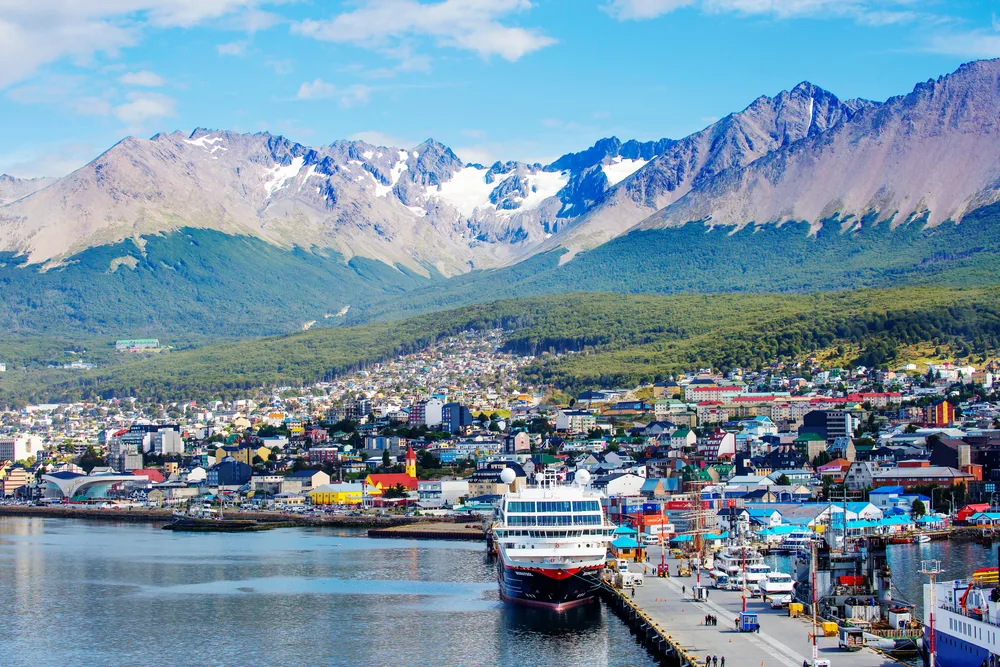
Ushuaia, Argentina, 02/22/2020, city view from the sea. Ushuaia is the southernmost city in Argentina (and according to some sources — on the entire planet), it is often called the “edge of the world/Galina Savina/Shutterstock
Here are a few other things to consider when planning your trip to Patagonia:
- The pleasantest time to visit Patagonia is December through March. It’s summer there, so you can get out and about easily.
- The cheapest time to visit Patagonia is in Northern Hemisphere fall and spring. These “shoulder seasons” will net you considerably lower prices.
- Don’t plan to come in winter. A lot of Patagonia is either cold or socked in, and you’ll miss some of the best sights.
- There are parts of Patagonia where you won’t find much English. Have your Spanish translation app on standby.
Frequently Asked Questions
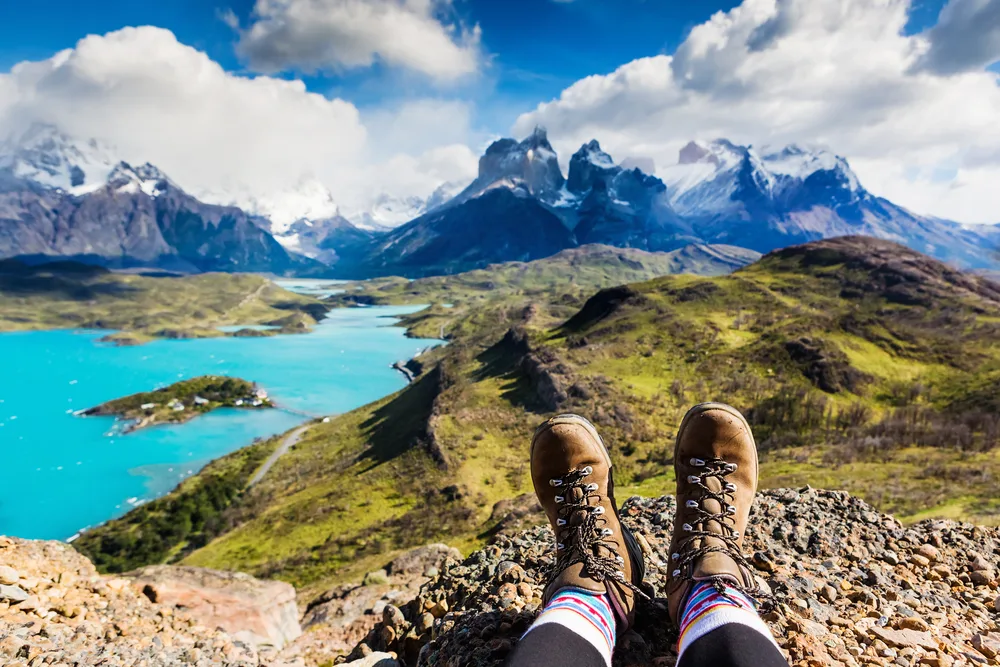
Olga Danylenko/Shutterstock
Here are some frequently asked questions about budgeting your trip to Patagonia:
Is Patagonia expensive?
It’s hard to answer how hard the question of how expensive Patagonia is, because it’s such a large area and the activities you can choose are so varied. In general, no, it’s not very expensive there.
The food and meals are affordable, rental cars and public transportation aren’t bad, and you can find good hotel prices if you take the time to price-shop. However, tours won’t come cheap!
Where should I go in Patagonia?
Where you go depends on what you want to see. If you enjoy fjords, go to Chile. If you want to see amazing glacial lakes, go to the Argentinian Lake District, where you’ll find cute boutiques, good food, and lovely scenery.
There are, of course, national parks everywhere, the best of which might just be Torres del Paine.
Is it safe in Patagonia?
Yes, Patagonia is fairly safe. We always recommend caution when traveling, especially alone, but even solo travelers and females can feel good coming here alone.
What’s the deal with camping?
You can camp in Patagonia for very little. Check “Accommodations” above to learn more about how this works, and you may save hundreds of dollars in lodging on your trip.
Are the Patagonia and Atacama deserts related?
Some people wonder, when searching for the best natural wonders in the Chilean/Argentinian regions, whether the famous deserts of Patagonia and Atacama are related.
The answer is that while both are deserts, they are far away from each other (more than 1,200 miles). And while the Patagonia desert is on the Argentina side, the Atacama desert is in the north of Chile.
Also, while both are clear and spectacular, they have different climates. In Atacama, the temperature usually hovers around a temperate 65 degrees Fahrenheit or so. It is windswept and barren and the driest place on Earth outside the poles.
Patagonia is similar, but it is more lush. It does not get much precipitation, like Atacama, because it is in the “rain shadow” of the Andes, which means the clouds break on the Andean peaks and leave little moisture left over for the desert on the other side.
However, it boasts vegetation and mountains in different areas, because the desert is only part of Patagonia, not the whole thing.
Over to You — Book Your Trip to Patagonia Today!
| 🛎️ Average Accommodation Cost | $100 per night |
| ✈️ Average Flight Cost | $900 per person |
| 🍽️ Food, Drink & Activities | $100 per person, per day |
| 🚕 Transportation | $500 total |
| 💲 Total Cost | $4,500 |
The average cost of a one-week trip to Patagonia is around $4,500 for two people. Get ready to enjoy one of Mother Earth’s most wonderful gifts and start booking today!



